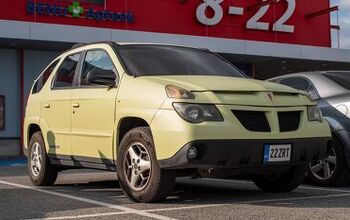SAIC Buys Half Of GM's Indian Ops, And Then Some

SAIC halted trading of its stock today due to a “major asset reorganization.” According to Dow Jones Newswire, SAIC’s board will hold a meeting before Dec. 9 to discuss the asset reorganization plan. SAIC said its shares will resume trading on the Shanghai Stock Exchange after it announces a detailed plan on the reorganization. While SAIC is tightlipped, Chinese media is abuzz with speculations.
Or it could be what Bloomberg thinks: GM will sell a 1 percent share in their 50:50 partnership to SAIC, so that SAIC will be able to consolidate the earnings. This due to an accounting rule change in China that goes into effect January 1, 2010. Let’s see whether GM will count the gadzillions of GM cars sold in China in the annual OICA ranking after they are in a minority position. Any bets?
Update: This just in from R euters:
“GM has agreed to sell half its Indian operations and a stake in its Chinese business to China’s SAIC Motor Corp, the New York Times reported on Thursday. The report said the information came from “people with a detailed knowledge” of the deal.”
The NYT confirms the 1 percent version floated by Bloomberg, and they think, GM just gave away much more than a percent: ” Michael Dunne, an auto consultant specializing in Asian markets, said that for G.M. to accept a minority holding in its main joint venture marked an inevitable decline in G.M.’s influence in China, which has overtaken the United States as the world’s largest auto market. “Dropping below the 50-50 partnership is huge — there may be a way to preserve voting rights, but symbolically, it is a step down,” Mr. Dunne said.”

Bertel Schmitt comes back to journalism after taking a 35 year break in advertising and marketing. He ran and owned advertising agencies in Duesseldorf, Germany, and New York City. Volkswagen A.G. was Bertel's most important corporate account. Schmitt's advertising and marketing career touched many corners of the industry with a special focus on automotive products and services. Since 2004, he lives in Japan and China with his wife <a href="http://www.tomokoandbertel.com"> Tomoko </a>. Bertel Schmitt is a founding board member of the <a href="http://www.offshoresuperseries.com"> Offshore Super Series </a>, an American offshore powerboat racing organization. He is co-owner of the racing team Typhoon.
More by Bertel Schmitt
Latest Car Reviews
Read moreLatest Product Reviews
Read moreRecent Comments
- Theflyersfan The wheel and tire combo is tragic and the "M Stripe" has to go, but overall, this one is a keeper. Provided the mileage isn't 300,000 and the service records don't read like a horror novel, this could be one of the last (almost) unmodified E34s out there that isn't rotting in a barn. I can see this ad being taken down quickly due to someone taking the chance. Recently had some good finds here. Which means Monday, we'll see a 1999 Honda Civic with falling off body mods from Pep Boys, a rusted fart can, Honda Rot with bad paint, 400,000 miles, and a biohazard interior, all for the unrealistic price of $10,000.
- Theflyersfan Expect a press report about an expansion of VW's Mexican plant any day now. I'm all for worker's rights to get the best (and fair) wages and benefits possible, but didn't VW, and for that matter many of the Asian and European carmaker plants in the south, already have as good of, if not better wages already? This can drive a wedge in those plants and this might be a case of be careful what you wish for.
- Jkross22 When I think about products that I buy that are of the highest quality or are of great value, I have no idea if they are made as a whole or in parts by unionized employees. As a customer, that's really all I care about. When I think about services I receive from unionized and non-unionized employees, it varies from C- to F levels of service. Will unionizing make the cars better or worse?
- Namesakeone I think it's the age old conundrum: Every company (or industry) wants every other one to pay its workers well; well-paid workers make great customers. But nobody wants to pay their own workers well; that would eat into profits. So instead of what Henry Ford (the first) did over a century ago, we will have a lot of companies copying Nike in the 1980s: third-world employees (with a few highly-paid celebrity athlete endorsers) selling overpriced products to upper-middle-class Americans (with a few urban street youths willing to literally kill for that product), until there are no more upper-middle-class Americans left.
- ToolGuy I was challenged by Tim's incisive opinion, but thankfully Jeff's multiple vanilla truisms have set me straight. Or something. 😉


































Comments
Join the conversation
I would wait for some actual information about the actual reasons why this was done (and what actually was done). Isn't there some sort of rules that a 50/50 JV can't export cars from China, at 51% could it then become a chinese owned corporation that could?
I don't understand why companies in JVs don't just count the percentage of cars equivalent to the percentage of ownership. If GM ends up with 49% of the SAIC JV, and the JV sells 100,000 cars, I don't see a problem with GM claiming 49,000 cars in their numbers.